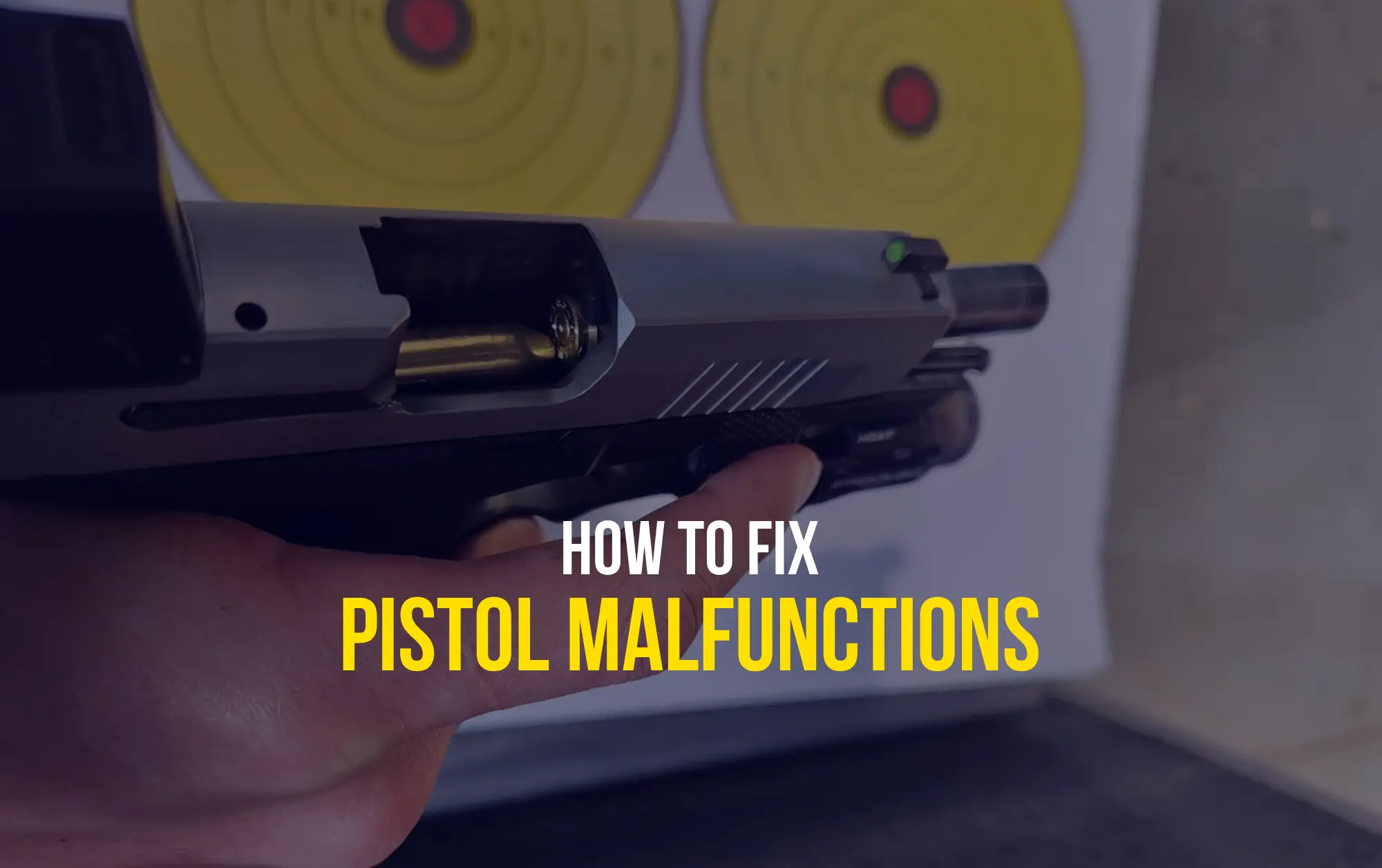Proper gun handling involves more than just knowing the four safety rules. Every aspect of owning and using a gun demands attention to safety. This includes cleaning, carrying, storage, etc. Today’s guide is about malfunction clearance, and it discusses the four types of gun malfunctions, what causes them, what clearance drills to do in what situation, and the tips for gun inspection and maintenance. Remember, reading about these practices online can’t replace real experience. So make sure to check out our pistol courses after you finish the article.
Why Gun Malfunctions Happen
Despite modern advancements in firearm technology and manufacturing that have made guns and ammunition more reliable than ever before, malfunctions can still occur. It’s crucial for gun owners to understand that these issues often stem from factors beyond the inherent quality of the firearm or ammunition. A primary cause can be the condition of the firearm itself; a gun that isn’t regularly cleaned can account for around 90% of firearm malfunctions. You should also pay attention to the state of individual components such as magazines, springs, and extractors. Recognizing the common causes of malfunctions, gun owners can take proactive steps to prevent them. So here are the most typical reasons:
- Ammunition Issues: Using the wrong ammo or low-quality rounds can lead to jams or misfires.
- Dirty Gun: Carbon buildup, dirt, or debris can mess with your gun’s functionality.
- Mechanical Problems: Worn or damaged parts (springs, extractors, etc.) can cause hiccups.
- Improper Handling: Mistakes during loading or firing can lead to jams.
- Environmental Factors: Extreme weather (heat, cold, or moisture) can impact performance.
- Magazine Troubles: Damaged or poorly seated magazines can cause feeding problems.
Common Types of Gun Malfunctions
The four major types of firearm malfunctions are misfire, misfeed, failure to extract, and failure to eject.
Misfire (Failure to Fire)
A misfire happens when you pull the trigger and nothing happens—no bang, no recoil. This can be caused by faulty ammo, an issue with the primer, or a weak firing pin. While rare due to improved ammo quality, it can still happen, especially with rimfire or hand-loaded rounds.
Subtypes of Misfire:
- Hangfire: A delay between pulling the trigger and the gun firing.
- Pop Fire: Instead of a bang, you hear a faint pop with no recoil.
How to Fix Misfire in a Pistol
In a non-defensive situation:
- Keep the gun pointed downrange for at least one minute to ensure safety.
- After waiting, carefully remove the round and unload the gun.
- Check the primer on the unfired round. If there’s a deep dent, it’s likely defective ammo. If the mark is shallow, the firing pin might not be hitting hard enough
- If the latter is the case, disassemble the firing pin assembly and thoroughly clean it.
- If this doesn’t resolve the issue, replace the striker or hammer spring.
In a defensive situation, do the Tap-Rack-Bang drill:
- Tap the bottom of the magazine to ensure it’s seated properly.
- Rack the slide forcefully to eject the round.
- Get back on target and fire immediately.
Misfeed (Failure to Feed)
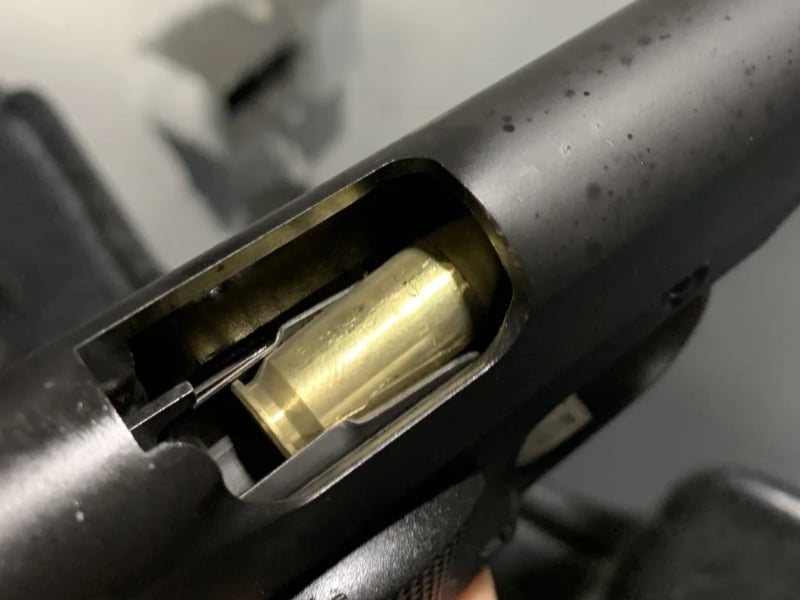
A misfeed occurs when a cartridge doesn’t enter the chamber fully. This is a common issue with semi-automatics and is usually caused by damaged magazine feed lips, weak springs, or dirt around the chamber, as well as as well as improperly seated magazines or faulty cartridges.
How to Fix Failure to Feed in a Pistol
Check if the magazine causes the failure to feed malfunction:
- Start by removing the magazine and clearing the chamber.
- Inspect the magazine. Look for damage to the feed lips and test the spring tension.
- Re-insert the magazine and try loading a round.
- If the problem persists, check the firearm for mechanical issues.
If the problem isn’t on the gun, adjust your technique. Misfeeds can sometimes result from a weak grip (“limp-wristing”), so keep a firm grip on the gun to help the slide cycle properly.
Failure to Extract
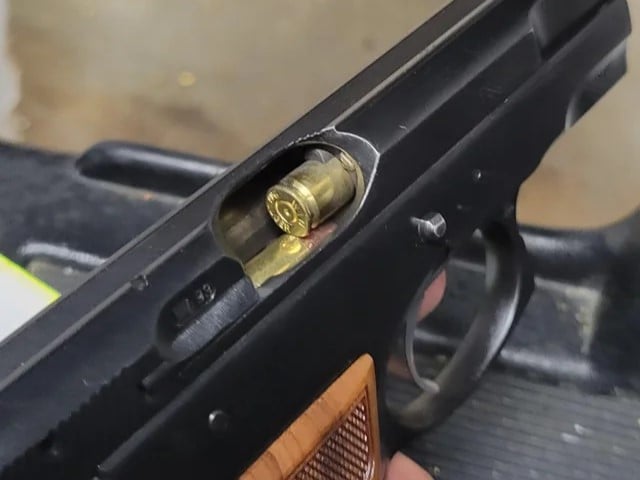
This occurs when the gun doesn’t properly remove the spent cartridge, leading to a jam when the next round tries to load or a double feed (two rounds competing for the same space). It can be caused by a damaged extractor claw, dirty extractor, failed extractor spring, or ammunition that falls outside the standard specifications (SAAMI specs).
How to Fix Failure to Extract in a Pistol
- Remove the magazine and clear the chamber of any unfired rounds.
- Rack the slide 2-3 times forcefully to extract and eject casings.
- If the casing is stuck, rack the slide a few times. You can use a cleaning rod to push out stubborn casings.
- Clean the chamber and extractor thoroughly, then inspect the extractor for damage. If it’s damaged or loose, visit a gunsmith for a replacement.
- If you suspect faulty ammo, avoid using any more from that box.
Failure to Eject (Stovepipe)
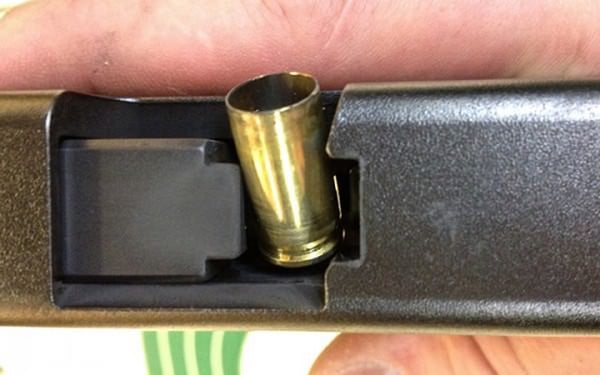
A stovepipe happens when the spent casing gets stuck in the ejection port, often standing upright like a… well, stovepipe. This can be due to a dirty chamber, a weak grip on the gun, or low slide velocity.
How to Fix Failure to Eject in a Pistol
In case of a failure to eject, do the Tap Rack Bang drill, like when dealing with a dud round.
- Tap the bottom of the magazine.
- Rotate the gun slightly so the ejection port faces downward, and rack the slide to eject the casing.
- Pull the trigger once the gun is cleared and safe to fire.
Proper Gun Cleaning & Lubing to Minimize Firearm Malfunctions
At this point, you understand how important it is to keep your firearm clean and maintained to prevent residue buildup, or “crud,” which can seriously mess with your gun’s performance. Crud in areas like the breech, chamber, or magazine can impact firing and cycling. If debris builds up on parts like the breech face, feed ramp, or extractor groove, you could face problems like misfeeds or light-firing pin strikes.
How Often to Clean Your Gun
First things first, set up a regular cleaning and lubing routine for your firearm. It’s generally advised to clean your gun after each use, especially for rimfire pistols and rifles, which are more prone to residue buildup. Carry pistols should be cleaned and inspected about once a month, while hunting firearms should be lubed and cleaned at the start and end of the hunting season.
Of course, how often you clean depends on how you use your gun. Some folks clean after firing 500 to 1,000 rounds, while others stretch it out to 2,000 to 5,000. Just make sure to lube your gun more often than you clean it. For instance, you might lube every 500 rounds and clean every 1,000 rounds.
How to Clean a Pistol to Avoid Malfunctions
Clean the chamber:
- Using a bore brush bent into an “L” shape, ensuring the short leg matches the length of a spent case – this will help to avoid getting the brush into the rifling.
- Insert the brush and move it back and forth to loosen carbon or lead buildup.
- Then, use a Q-Tip to remove the debris before running a patch through the bore.
Clean the bore:
- Use a nylon brush and cleaner. Never use a metal brush in the bore.
- Never clean from the muzzle to prevent damaging the crown which would adversely affect accuracy.
- For a quick pass through the bore, use a pull-through device crafted from a nylon string. For a deeper clean, use a jag from the breech end.
Clean the slide assembly:
- Use a nylon brush and cleaner.
- Remove the slide from the frame to clean the bottom and face of the breech block.
- Clean underneath the extractor, inside of the slide, recoil spring guide, and the recoil spring.
Clean the frame:
- Use a toothbrush and Q-Tips to clean around the locking insert and down in the bottom of the frame and into the mag well. Also, clean the front and rear rails, the back end of the frame around the ejector, the slide catch lever, the decocking lever, and the back around the hammer.
- Be cautious around the slide stop to avoid damaging the small hairspring.
- Avoid immersing the frame or washing it with solvent sprays to protect the factory lubrication of the sear and hammer, which ensures their longevity. Only a qualified gunsmith should immerse the frame during a complete teardown of the pistol, as relubrication of the sear and hammer requires their removal. Also, don’t lube the striker.
- For oiling, apply oil with a Q-Tip to the contact areas between the frame and slide rather than directly from the bottle.
- Use minimal lubrication to prevent attracting contaminants, as excessive lube can cause wear and is not meant to enhance function but to prevent wear.
Clean the magazine:
- Disassemble the magazine and use a nylon bore brush to remove accumulated debris and lube.
- Rinse the magazines with solvent to ensure all residue is cleaned out.
- Apply a light coat of oil using a Q-Tip to finish the cleaning process.
- Inspect the follower button track for chatter marks, which may indicate the need for replacement.
Lube the pistol:
- You must lube your gun after it has been cleaned.
- Lube the barrel sparingly with good gun oil, such as CLP, Breakfree, etc.; 2-3 drops on the barrel are sufficient.
- Apply 2-3 drops of oil on the frame rails until it’s wet to the look.
Reassemble the pistol:
- Following the factory recommendation, place the barrel into the slide assembly, making sure it falls into place.
- Then, reassemble the recoil guide rod and recoil spring. Make sure, they are firmly reassembled to prevent them from flying off.
- Turn it over holding it in your left hand. Allow the slide to glide back onto the receiver.
- Pushing the slide straight back.
- Work the slide back and forth a few times to be sure it’s functioning properly.
Inspect your pistol:
Inspect your firearm periodically. Before inspection, make sure the gun and the magazine are empty.
Taking a Closer Look at Gun Malfunctions Causes
Ammunition
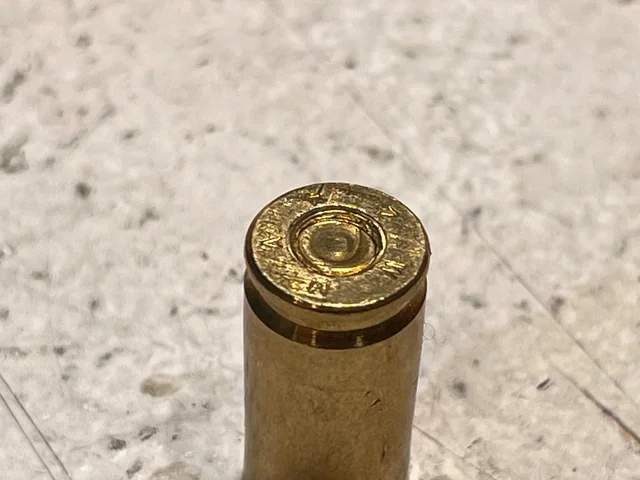
Even though ammo is made using standards set by SAAMI or CIP, there can still be tiny variations in cartridge designs. Normally, this isn’t a problem—assuming your firearm is properly chambered. But there are a few ammo-related issues that might cause your gun to malfunction.
First up, check out the length of the shoulder-to-rim on your ammo and compare it with your gun’s chamber length. Some pistol manufacturers design their chambers to be a bit shorter to boost accuracy. If the bullet’s shoulder is too long for the short chamber, it can stop the bolt from fully closing, resulting in a misfire. If this happens a lot, it might be time to try another ammo brand.
Another common issue? Hand-loading ammo light to reduce recoil. If you load too light, it can lead to stovepipe malfunctions. The easy fix here is swapping out your recoil spring for a lighter one.
Defective primers can also cause issues. If the primer isn’t placed right—so the anvil doesn’t hit solidly—a misfire known as a “click” can happen.
Particularly with .22LR and other rimfire cartridges, misfires can just be bad luck because of how the primer compound works. If you notice a solid firing pin strike and no bang, odds are it’s not your gun, it’s the ammo.
Magazine
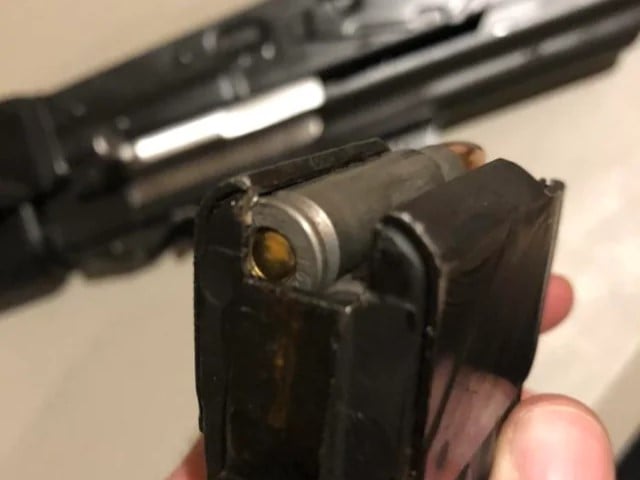
Your magazine is another place where trouble likes to hide. Over time, the feed lips and spring can wear out, leading to misfeeds and misfires. If the feed lips get bent or damaged, they won’t hold the round securely. This might cause the bullet’s nose to point up, which prevents it from chambering correctly; this can lead to a “tip-up” malfunction. Additionally, a weak magazine spring may not adequately push the rounds into position, causing them to bounce loosely.
Regularly inspect your magazines. Check for bent feed lips and make sure the spring has enough tension. It’s a simple habit that can save you from a lot of headaches and keep your gun running smoothly.
Extractor & Ejector
When the extractor doesn’t hold an empty case properly, it might not hit the ejector at the right angle, preventing it from leaving the ejection port smoothly. This can cause the case to spin incorrectly and stop the next round from feeding into the chamber. Replacing a worn or misaligned extractor often fixes this. The ejector is also crucial for proper operation. If it’s loose, it might put uneven resistance on the bolt, leading to ejection issues. A bent or damaged ejector can also affect how cases are extracted. Regularly check the extractor and ejector to ensure they are in good condition.
Recoil Guide Rod & Spring
Over time, the guide rod might get rusty or damaged, which can increase friction and make the slide move less smoothly. This can cause problems with feeding or ejecting cartridges. To mitigate these issues, check the guide rod regularly for any damage. Similarly, the recoil spring will wear out as it’s compressed and used. As it ages, it might not move the slide as effectively. Simply replacing the spring with a new one can fix misfeeding.
Don't Dry-fire Rimfire Guns
You must never dry fire .22 caliber guns. Period. The problem is that the travel on firing pins in rimfire guns is longer and can hit the metal edge of the chamber if there’s no round. This repeated impact can damage the chamber’s edge, making it harder for bullets to load and casings to eject. To avoid these issues, use a dummy round or snap cap when dry-firing.
Pistol Malfunctions FAQ
A hangfire is a situation where there’s a delay between pulling the trigger and the discharge of the firearm, typically caused by a delay in the ignition of the propellant.
A misfire happens when the firing pin strikes the primer but the cartridge fails to discharge, often due to faulty ammunition or issues with the firearm.
If you suspect a hangfire, keep the firearm pointed in a safe direction and do not attempt to open the action or remove the cartridge immediately. Wait at least 30-60 seconds to ensure it does not discharge unexpectedly before handling the firearm further.
Several factors can lead to a gun jamming, including dirt and debris in the action, worn or damaged parts, improper lubrication, or faulty ammunition. Regular cleaning and maintenance are essential to prevent jams.
The three most common malfunctions are: 1. Failure to Fire (Misfire), when the cartridge doesn’t go off due to faulty ammunition or primer issues. 2. Failure to Extract, when the spent casing fails to leave the chamber, possibly due to an extractor problem. 3. Failure to Eject, when the spent casing isn’t expelled from the firearm, often caused by issues with the ejector or recoil mechanisms.
To check if a gun is clean, disassemble it according to the manufacturer’s instructions, inspect the bore, action, and chamber for dirt, residue, or corrosion, and ensure all moving parts are free of debris and well-lubricated.
How do you check if a gun is loaded? To check if a gun is loaded, point the firearm in a safe direction, engage the safety, and then open the action to visually inspect the chamber and magazine. Always ensure that the gun is unloaded before handling or cleaning.
A failure to feed can occur due to several factors, such as a worn-out magazine spring, dirty chamber, faulty recoil mechanism, or improper ammunition. Ensuring these components are in good condition can help prevent the issue.
When a gun doesn’t fire as expected, it is commonly referred to as a misfire.
When a gun misfires, keep it pointed in a safe direction. Wait a few seconds in case of a hangfire, then safely open the action to remove the cartridge and inspect both the ammunition and the firearm for any issues before attempting to fire again.
Clearing a jammed gun involves safely removing the magazine, meticulously clearing any obstructions, visually inspecting the chamber, and addressing mechanical issues or replacing worn components before reassembling and checking for proper function.
